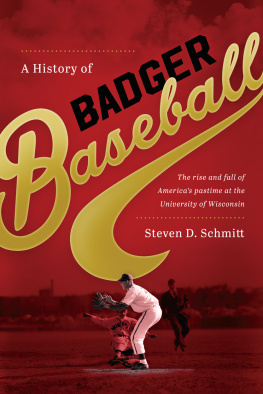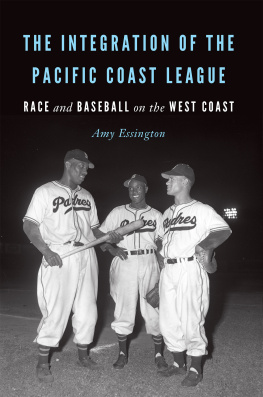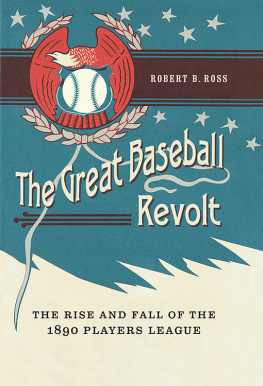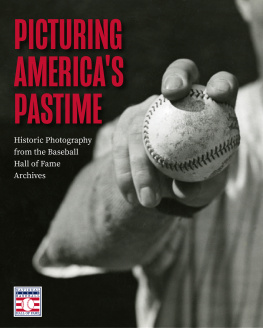Publication of this volume has been made possible, in part, through the support of former UW baseball players and coaches, many of whom were interviewed for this book, and the Dugout Club, Inc.
The University of Wisconsin Press
1930 Monroe Street, 3rd Floor
Madison, Wisconsin 53711-2059
uwpress.wisc.edu
3 Henrietta Street, Covent Garden
London WC2E 8LU, United Kingdom
eurospanbookstore.com
Copyright 2017
The Board of Regents of the University of Wisconsin System
All rights reserved. Except in the case of brief quotations embedded in critical articles and reviews, no part of this publication may be reproduced, stored in a retrieval system, transmitted in any format or by any meansdigital, electronic, mechanical, photocopying, recording, or otherwiseor conveyed via the Internet or a website without written permission of the University of Wisconsin Press. Rights inquiries should be directed to .
Printed in the United States of America
This book may be available in a digital edition.
Library of Congress Cataloging-in-Publication Data
Names: Schmitt, Steven D., author.
Title: A history of Badger baseball: the rise and fall of Americas pastime at the University of Wisconsin / Steven D. Schmitt.
Description: Madison, Wisconsin: The University of Wisconsin Press, [2017] | Includes bibliographical references and index.
Identifiers: LCCN 2016041569 | ISBN 9780299312701 (cloth: alk. paper)
Subjects: LCSH: Wisconsin Badgers (Baseball team)History. | University of WisconsinBaseballHistory. | University of WisconsinMadisonBaseballHistory. | BaseballWisconsinMadisonHistory. | Baseball teamsWisconsinMadisonHistory. | Baseball playersWisconsinMadisonHistory.
Classification: LCC GV863.W52 M337 2017 | DDC 796.357/630977583dc23
LC record available at https://lccn.loc.gov/2016041569
ISBN 9780299312787 (electronic)
A History of Badger Baseball: The Rise and Fall of Americas Pastime at the University of Wisconsin is dedicated to the memory of James L. Baughman, professor of journalism and mass communication at the University of WisconsinMadison. A mentor and friend, Professor Baughman taught me and all his students three basics: assume nothing, challenge the conventional wisdom, and be a rigorous scholar.
History has a long shelf life.
James L. Baughman to the author, 2007
Illustrations
Foreword
Allan H. (Bud) Selig
As a graduate of the University of WisconsinMadison, and as the former owner of the Milwaukee Brewers and the ninth Commissioner of Baseball, I found Steven D. Schmitts book, A History of Badger Baseball: The Rise and Fall of Americas Pastime at the University of Wisconsin, to be of great interest and a remarkable and outstanding achievement. It is not only a history of University of Wisconsin baseball; it is much more than that. The author doesnt just present a broad outline of the good times and the bad times, the successes and the failures, and a list of the notable figures. He gives the reader a veritable pitch-by-pitch account of more than one hundred seasons of baseball. He begins with describing how a handful of players formed the institutions first baseball team in 1870 until the university dropped baseball as an intercollegiate sport because of, as he explains, budget cuts, the lack of a first-class facility, and the need to equalize athletic participation for men and women.
Along the way, he describes Badger baseball season by season, the highlights, the heroes, and the drama. One of the most compelling sagas is a 1909 trip that University of Wisconsin baseball players made to Japan, which Mr. Schmitt claims is the longest trip ever taken by college athletes. It certainly was at the time. In fact, such trips were extremely rare. Only a year earlier, in 1908, the Reach All America Team, a group of professional baseball players sponsored by a sporting goods manufacturer, toured Japan, China, the Philippines, and Hawaii. They played seventeen games in Japan and won them all. The Badgers, it is believed, were the first group of amateurs to tour Japan, and it is hard to imagine how a group of young men at that time could have embarked on such an excursion. Today, you board a plane and half a day later, you land in Tokyo. In 1909 the Wisconsin baseball players left Madison on August 20 and didnt return until October 31. The Badgers won five of nine games, which the author describes in detail, but more interesting is the cultural differences thatcertainly existed at the time and the interaction among the young American ballplayers and their Japanese hosts and competitors. Schmitt writes: The Badgers on-field chatter shocked Japanese fans. He quotes one of the Wisconsin players who wrote after the trip: They hissed us because it was a custom of theirs to carry on all contests in silence and we had broken it. We kept on with the talk, however, and before the series was over they paid no attention to it, and even sanctioned it on the part of their own boys, who picked it up very readily.
The author gives other examples of the cultural adjustments the young men from Madison had to make both on and off the field of play. He also writes that the New York Times reported at the time that the competition generated so much interest in the game throughout Japan that it helped lead to the creation of a professional league in Japan.
Schmitt goes into great depth in describing the season-by-season journey, complete with highlights as well as disappointments. He shines a light on some of the best players who attended Wisconsin, including shortstop Harvey Kuenn, a lifetime .303 hitter in the big leagues, who managed two years for me with the Brewers; outfielder Rick Reichardt, who had an eleven-year major league career; and pitcher Paul Quantrill, who pitched fourteen years in the majors, mostly in relief.
Not unexpectedly, the biggest disappointment Schmitt describes comes near the end where he goes to great lengths to explain the decision behind dropping varsity baseball as an intercollegiate sport. There is no doubt where the author lines up in this drama, and he continues to hope that the day will come when Badger baseball is revived. It is a hope shared by many alums and baseball fans.
Allan H. (Bud) Selig is a 2017 inductee into the National Baseball Hall of Fame.
Acknowledgments
A History of Badger Baseball: The Rise and Fall of Americas Pastime at the University of Wisconsin is one big acknowledgment in itself. Every University of Wisconsin baseball player, coach, manager, reporter, and fan is responsible for this book. The program lasted for 117 seasons without first-class facilities, budgets, and athletic department support. This book would not have been possible without the dedication of the people involved in the UW baseball program, from the players who formed the first baseball team in 1870 to the players who won championships to the boosters who funded spring trips to warm climates where the Badgers took on some of the best teams in the country.
Special thanks must be given to those who helped make this project a success. UW Archives director David Null and image and media archivist Vicki Tobias granted every request and spent hours scanning the photographs that help bring this book to life. The Wisconsin Historical Society provided assistance with reviewing decades of newspaper microfilm and ProQuest newspaper archives, as well as documentation of UW buildings and maps showing the locations and evolution of UW athletic fields.
The UWMadison Division of Intercollegiate Athletics cooperated from the start in providing access to media guides and other archival materials, including scorecards. Former Badger coach Tom Meyer supplied photographs and contacts with state baseball organizations such as the Wisconsin High School Baseball Coaches Association and the Old Time Ballplayers Association of Wisconsin, which support the return of varsity baseball to Wisconsin. Other Big Ten athletic communications departmentsparticularly Minnesota, Purdue, Michigan State, and Nebraskahave also provided data on team histories, baseball budgets, and new ballparks opened in recent years.











